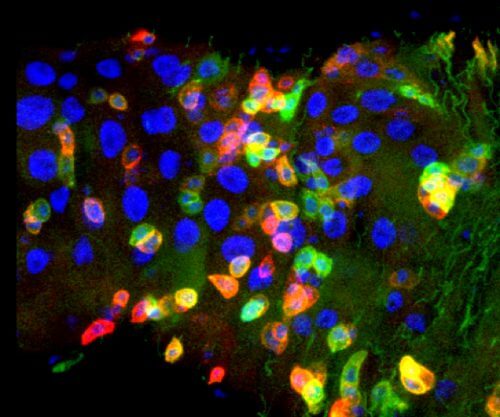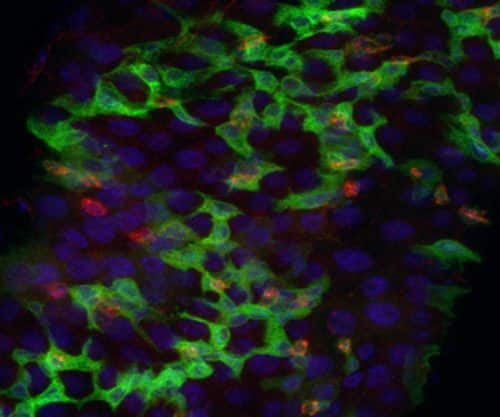A study conducted at the Technion shows that disruptions in this mechanism, typical of aging, are involved in many diseases, including diabetes, cancer and degenerative brain diseases

Researchers at the Rappaport Faculty of Medicine at the Technion present in the journal eLife new aspects of the mechanism that preserves the identity of mature body cells. The preservation of the cellular identity is essential for the physiological functioning of the cell and the tissue and for the survival of the living creature. The study was conducted by the researchers of the Faculty of Medicine, Prof. Amir Orin, Dr. Naama Flint-Broadsley, Dr. Olga Boyko, Adi Sheft, and Aliya Lotan-Bitman. The study focused on enterocytes - the main mature cells in the inner wall of the small intestine in the Drosophila fly model. The rapid aging of Drosophila flies allows researchers to trace processes in their development at a relatively high speed. Furthermore, the cellular structure of the fermentation fly intestine is relatively simple and therefore convenient for research.
In multicellular organisms, the sorted body cells are produced - skin cells, bone cells, intestinal cells, etc. - by stem cells that are a kind of "factory" for the production of sorted cells. The stem cells and the differentiation mechanism occupy many research groups around the world. The technical research group, on the other hand, examined what happens after differentiation - how the enterocytes, for example, maintain their identity as enterocytes.
"It turns out that the preservation of cellular identity is not a default," says Prof. Orin. "The fact that an intestinal cell does not turn into a skin cell at some stage, for example, is not self-evident. This situation requires a constant effort from the physiological control mechanisms. A bit like in a human relationship, here too it is not enough to initiate; You also have to work to maintain the functioning of the system."
The researchers explain that without strict control over the preservation of cellular identity, the gene system necessary for the sorted cell will cease to be expressed, and irrelevant programs will be expressed out of place - for example, heart genes will be expressed in intestinal cells. These disruptions will impair the tissue's ability to perform its tasks. This disruption is accompanied by processes such as re-differentiation
((pathological de-differentiation, which turns the sorted cell into a new type of cell and may lead to disease states such as cancer and progeria-like diseases - a disease characterized by accelerated human aging and resulting from mutations in the nuclear lamin protein. Therefore, the integrity of the mechanism that maintains the cellular identity of mature cells is very important.

The Technion researchers discovered that two of the key factors in the preservation of cellular identity are the transcription factor Hey and the nuclear lamins. Transcription factors are central players in the genetic control mechanism. Their influence is focused on the translation of the genetic information from DNA Hey for mRNA - the molecule that contains the information necessary for the construction of the proteins in the cell. Their proper function is essential for the proper creation of proteins, as well as for the proper functioning of the entire organism. The researchers found that the transcription factor Hey encourages the expression of the hemin protein that is unique to the adult cell and prevents the expression of the hemin present In the parent cells. In the mature cell, the lamin protein and Hey shape the structure of the cell's nucleus, a design that requires continuous and continuous control; in aging cells, the level of Hey decreases, and this decrease leads to the loss of the cell's identity and disruptions in it.
Following the understanding of the control mechanism based on Hey, the researchers showed that in intestinal enterocytes, a genetic deficiency targeting Hey or the lamin protein leads to premature aging of the intestinal tissue and premature death of young flies, similar to the physiological process that occurs in old age. Conversely, strengthening the expression of the Hey gene in enterocytes prevents the appearance of the defects associated with the aging of the intestinal cells and thus improves the function of the intestinal tissue and slows down its aging.
This discovery is a breakthrough in understanding the extensive network of controllers that maintains the identity of mature cells. The translation of these findings to cancer and aging processes is a basis for improving treatments for aging-related diseases. Furthermore, the understanding of the aforementioned control network will allow it to be inhibited for the benefit of a significant improvement in stem cell engineering and the correction of various medical disorders.
Prof. Amir Orin, a graduate of the MD/PhD track at the Rappaport Faculty of Medicine at the Technion, is the head of the Stan and Ruth Flinkman Laboratory for the Study of Genetic Networks at the Faculty of Medicine and a member of the Integrated Cancer Research Center at the Technion (TICC).
The research was supported by grants from the Israel Science Foundation, the Rapaport Institute for Medical Research and the Ruth Marandy-Flinkman Cancer Research Fund.
